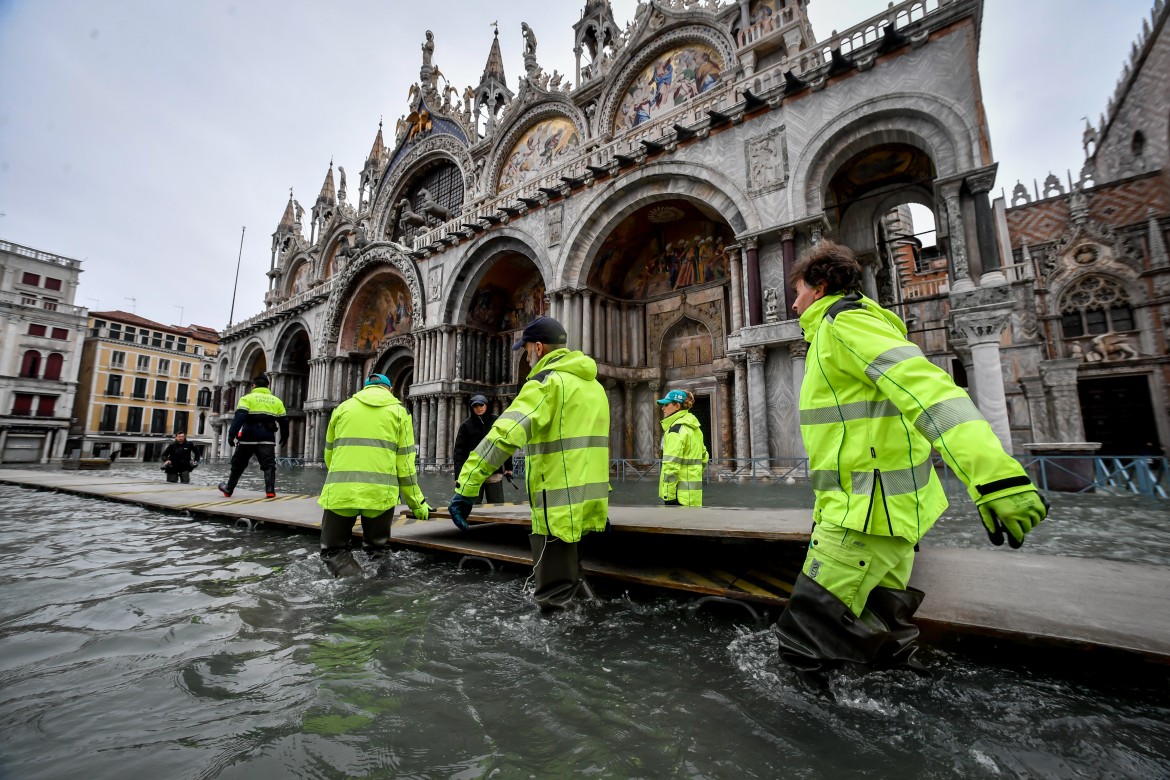Reportage
In Venice, a weekend deluge whose losses are more than money
Life is slowly returning to normal in Venice after a high tide emergency that halted transportation, closed schools, and caused millions in damage. Cultural heritage, from mosaics to handwritten classical compositions, were destroyed.

Six days after the high waters came, Venice is still here: “picada a un ciodo,” (“hanging from one nail”), as the locals say, but alive.
The schools are still closed, and the students are going around with brooms and mops to help those in need. There are a large number of retirees supporting them as well, plumbers and electricians who have taken up the tools of their trade once more and are helping out anyone who needs them. By Sunday, the shops were slowly returning to normal, because the tides on Friday and Sunday turned out to be less high than expected.
A third high tide was expected for Sunday at 12:30 p.m., with a forecast from the Tide Center—which got quite a few predictions wrong during these days of emergency—of 160 cm above sea level. It was a scary number, and not just because the city would have been 80 percent flooded once again, but also because this was the level predicted for the night of the flooding disaster last week, when, because of a “wall” of southerly wind pushing the water in, it went all the way to 187 cm, almost reaching the record of that terrible day Nov. 4, 1966.
[Editor’s note: Fortunately, the weather gave the city a break on Sunday, as a weather front blocked the winds from the south and the tide peaked at around 150 cm, dropping toward the evening.]
Stefano Fiorin has a lot of years under his belt and he remembers that November in 1966. He is a well-known fisherman in Venice, who uses his boat not just to catch fish, but also to transport garbage bags. When he sees one put out by local residents, he takes it and delivers it to the differentiated collection points run by Veritas, the company that manages the waste cycle in Venice. The lagoon is his home, and who wouldn’t work to keep their home clean?
“I’ve never seen so many discarded bags in the canals like these days,” he says. “The big difference between the high water in ‘66 and this one is the plastic. Fifty years ago, there was none. At least not like in our times. Today, the lagoon has been invaded by it. I picked up what I could, but I had to bring everything home because Veritas has not restarted waste collection yet. They’re saying they still can’t do it at this point.”
Public transport is doing better. With the exception of a few direct lines to Lido and half a dozen stops that have been damaged by the tides, the service is back in operation. There are still major inconveniences, however, because, despite the fact that the waters these days are lower than at their peak, boats and public transport vessels are sometimes forced to stop because they can’t pass under the bridges.
The Council of Ministers in Rome has approved the request by the city and region of Venice and has declared a state of emergency for both the city of Venice and for all other areas of the Veneto region affected by the flooding. The government has officially allocated the first tranche of funding for disaster recovery, amounting to €20 million. Funds will be granted to individuals who have suffered damages for a maximum of €5,000, and to enterprises for a maximum €20,000. The Venetian city administration has decided to postpone the deadline for paying the waste tax (TARI) for one month, from Nov. 16 to Dec. 16, for both businesses and residents. The municipality has called on citizens to document the damage and submit their applications for reimbursement.
Furthermore, the Italian Banking Association (ABI) has also mobilized and called on individual banks to take into account the needs of those who have suffered damages from the flooding. BNL and Unicredit have suspended the payment of loans, granting a one-year moratorium to debtors. These banks have also launched a special solidarity loan on favorable terms to support the economic recovery.
Mayor Luigi Brugnaro is talking vaguely about “a billion in damages.” That figure is more or less arbitrary, because the assessment of the damages has not even started yet, nor does anybody know when it will end, given that the state of emergency is not yet gone.
Not to mention that there are also losses for which the banks are powerless to compensate. For example, the damage that the saltwater has caused to the delicate mosaics of St. Mark’s Basilica and its crypt. Or the music sheets hand-penned by Antonio Vivaldi, Benedetto Marcello and other great figures from the history of music that were stored in the library of the Benedetto Marcello Conservatory, and which have been irremediably damaged.
Not everything in the world can be measured in schei, as the locals would say.
Originally published at https://ilmanifesto.it/venezia-studenti-e-pensionati-al-lavoro-nelle-calli/ on 2019-11-17
